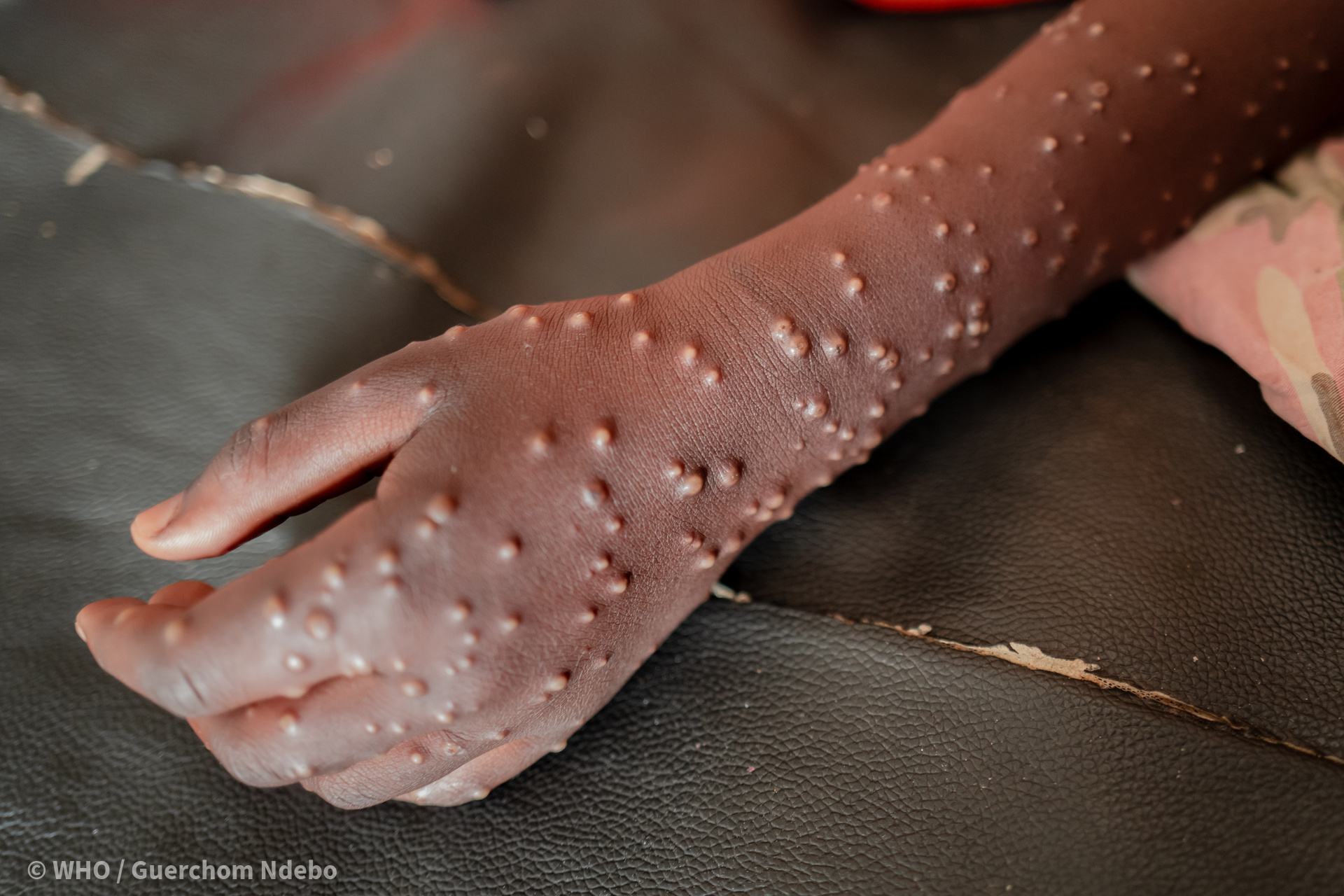
Skin lesions that are characteristic of mpox are seen on a young patient at Kavumu hospital in South Kivu province, Democratic Republic of the Congo, on August 30, 2024. Photo Credit: WHO
The first case of mpox virus of West African clade 2 has been reported from India in a person who had travelled abroad. But there is no need to panic.
Laboratory testing has confirmed the presence of the mpox virus of the West African clade 2 in the patient, a young male who recently travelled from a country experiencing ongoing mpox transmission. He is currently isolated at a designated tertiary care isolation facility. The patient remains clinically stable and is without any systemic illness or comorbidities.
The Union Health Ministry stated today this case is an isolated case, similar to the earlier 30 cases reported in India from July 2022 onwards, and is not a part of the current public health emergency (reported by the World Health Organization) which is regarding clade 1 of mpox.
Clade 2 is not part of the current public health emergency. The patient is stable and there is no immediate risk to the public.
Also read: Mpox spread is a public health emergency of international concern: WHO
Mpox (formerly known as monkeypox) is an infectious viral disease affecting humans and other animals.
It is caused by a DNA Virus, unlike the COVID virus which is an RNA virus. RNA virus undergoes rapid mutations.
Symptoms of mpox: Symptoms include a rash -> blisters -> crusts over, fever, swollen lymph nodes, exhaustion, muscle aches, and sore throat.
In some people, the first symptom of mpox is a rash, while others may have a fever, muscle aches or sore throat first.
The mpox rash often begins on the face and spreads over the body, extending to the palms of the hands and soles of the feet. It can also start on other parts of the body where contact is made, such as the genitalia.
A rash starts as a flat sore, which develops into a blister filled with liquid that may be itchy or painful. As the rash heals, the lesions dry up, crust over and fall off. Some people may have one or a few skin lesions and others have hundreds or more. These can appear anywhere on the body including the palms of hands and soles of feet, face, mouth and throat groin and genital areas, and anus.
Note: Blisters are a feature of Chicken Pox but chicken pox is not usually associated with Swollen Lymph Nodes. Secondly, mpox blisters are mainly on palms and soles.
Latent period: The time from exposure to the onset of symptoms ranges from 3 -17 days,
Duration: Symptoms last from 2-4 weeks.
Symptoms can be severe, especially in children, pregnant women, or people with suppressed immune systems.
Transmission: Close contact includes
◆ skin-to-skin such as touching or sex
◆ mouth-to-mouth, or lip kissing
◆ mouth-to-skin contact (such as kissing),
◆ face-to-face with someone who has mpox (such as talking or breathing close to one another, which can generate infectious respiratory particles).
Occasionally surface touch to abraded skin, and mucus membranes like the nose, and eyes. So handwashing is important.
Hand wash with soap water or alcohol-based sanitizer.
Avoid
◆ Sharing Mobile Phones
◆ Sharing towels, bed linen etc
Mpox is usually transmitted from one person to another through contact with infectious lesion material or fluid on the skin, in the mouth or on the genitals; this includes touching, close contact, and during sex.
The disease is not known to spread by air respiratory route – for example, across rooms, in markets or classrooms, etc.
At Risk:
-Sex workers and their clients
-Men having sex with men
-People with multiple sex partners
-Close contacts
-Health workers (use PPE, hand washing, mask)
Period of infectivity: Until all their lesions have crusted over, the scabs have fallen off and a new layer of skin has formed underneath, and all the lesions on the eyes and in the body (in the mouth, throat, eyes, vagina and anus) have healed too, which usually takes from 2 to 4 weeks.
Diagnostic method: Viral DNA PCR on blister Fluid/ Scraping/Scab
Differential diagnosis: Chickenpox, smallpox, scabies
Prevention: Smallpox vaccine, hand washing, covering rash, PPE, social distancing
Vaccination: Limited human studies and some animal studies have shown protection against mpox following vaccination with smallpox vaccines
MVA -BN or JYNNEOS (live attenuated non-replication vaccine given ID or SC).
However, only those with a high risk of exposure are advised to have the vaccine.
Does Chickenpox vaccination protect against Mpox?
No. If someone has chickenpox vaccination or infection, it offers no cross-protection against mpox because they are entirely different and unrelated viruses.
However, the skin lesions look the same in both. One can be confused with the other.
Does previous vaccination against smallpox provide any protection against mpox?
Unlikely so. Several cases of mpox have been reported in previously immunized persons with smallpox. The best is to take precautions.
Treatment: Supportive treatment, pain fever management nutrition hydration Isolation. Prevention of secondary infection
Medication: Tecovirimat, not yet freely available but as a trial enrollment.
Prognosis: Most people recover
Should we curtail foreign trips?
No. Just observe safe sex practices and avoid contact with high-risk community
Will mpox blow up like COVID?
No. Because it is a DNA Virus which does not change so often. The vaccine is already in place. Treatment is already in place. High-risk communities are limited.
Nevertheless, be informed and vigilant.
*Dr. Satish Kumar Gupta is an MD in Medicines, a Fellow of Royal College of Physicians, London, a Visiting Senior Consultant Physician and Internist at Max Super Speciality Hospital, and a Clinical Assistant Professor at GS Medical College, Chaudhary Charan Singh University, Meerut. He is the author of Journey of COVID in India: A Doctor’s Perspective.






🦠 India has reported its first case of mpox from the West African clade 2, but there’s no need to panic! The patient is stable and isolated. While symptoms can vary, public health authorities confirm that this case does not pose an immediate risk. Stay informed and take care! 🇮🇳💉 #Mpox #PublicHealth